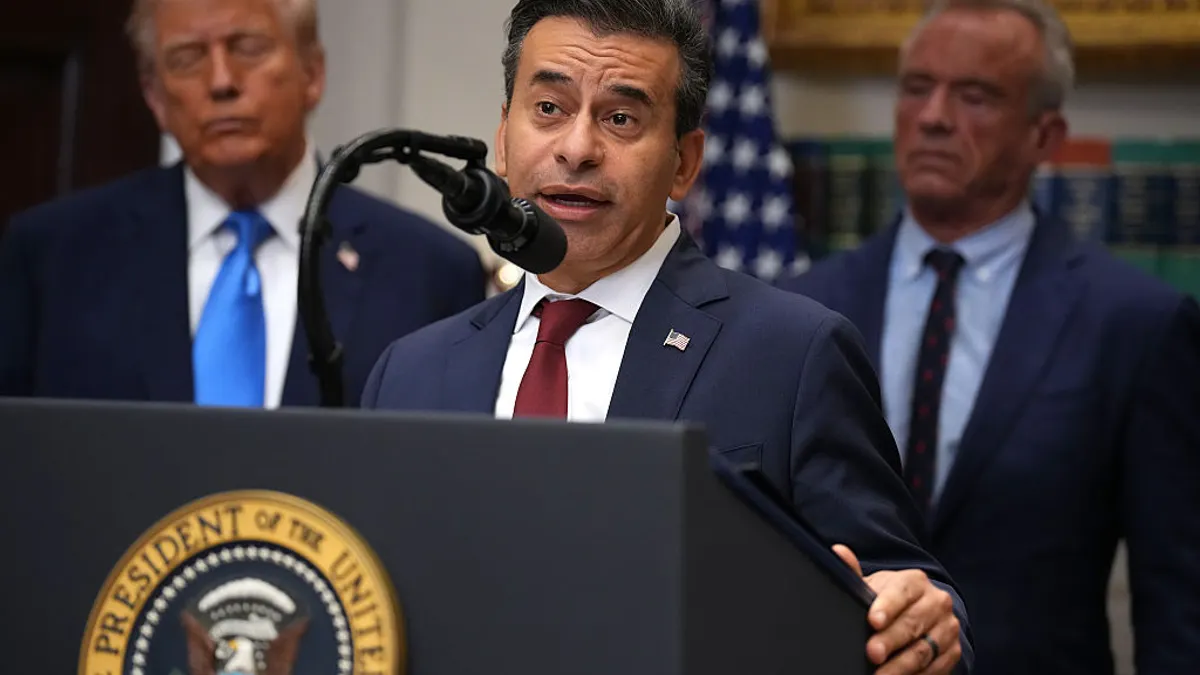The threat of tariffs looms over the pharma industry, and drugmakers are looking for ways to be vigilant and nimble in response to potential changes.
While the Trump administration exempted pharmaceuticals from reciprocal tariffs announced in early April, it was far from a guarantee that they’d forever be outside the crosshairs. At the time, the Department of Commerce had already begun an investigation to determine whether imported drugs and ingredients present a national security threat.
The results of the inquiry could provide justification for new tariffs on drugs, turning up the heat on an industry already grappling with other drug pricing control efforts, including a controversial “most favored nations” policy proposal. The executive order directing U.S. health agencies to design a rule that aligns American drug prices with the lowest price paid in any nation could put substantial pressure on the industry.
Leaders at the lobbying group PhRMA, in comments submitted as part of the investigation, said they hope the Trump administration will use the findings to enact targeted national security initiatives, rather than impose broad tariffs on pharmaceuticals.
Still, companies should brace for levies.
“It's a wait-and-see approach now to understand the timing of what any action might look like,” said Christine Kachinsky, KPMG’s U.S. national tax sectors leader and life sciences tax industry leader.
In the meantime, companies need to focus on three things to prepare for tariffs: monitoring, modeling and mitigation, Kachinsky said.
Know thy supply chain
The first step pharmaceutical companies should take is to assess their supply chain and see where vulnerabilities lie — which can be complicated.
“This is a sector where the tariff issue is arguably more complex than in many other sectors because of the complicated supply chains and the determination of value,” Kachinsky said.
Not only do companies have to know where products are coming from, but they must also determine the country of origin, which is not always straightforward. Most often, the country of origin is where the API was manufactured. But it can shift to the finished dosage form if there’s substantial transformation, which can occur when the product contains multiple APIs.
“The second step is to determine how the product is classified,” said Chris Young, principal, trade and customs, at KPMG.
Pharmas need to ask questions like: Is it on an exclusion list? How is the product going to be used? Are there specific reliefs in place? For example, if a company is using the product for testing, as is the case with a prototype, they don’t necessarily have to pay all the tariffs on it, Young said.
Finally, it’s critical to ensure the product value is accurate, so companies are paying tariffs on the correct amount, he said.
Value calculations are particularly complex when companies perform individual elements of the manufacturing processes across jurisdictions, Kachinsky added. Each jurisdiction must be compensated fairly for its contribution.
Reshoring efforts
As companies develop mitigation strategies, they will need to consider both short-term approaches, such as changes in sourcing, and long-term options, such as manufacturing shifts. One of the main goals of the Trump administration’s tariff policy is to encourage companies to move manufacturing operations to the U.S. Many companies already support the idea of bulking up U.S. manufacturing sites to protect against supply chain disruptions.
Drugmakers might value improved market stability for U.S. products, despite the cost of making the move, said Pankit Bhalodia, a partner in life sciences at West Monroe. Recently, interest has ticked up in manufacturing investment, he said, and the industry could see M&A activity rise in the manufacturing arena.
There are still reshoring hurdles yet to overcome, though, including the high cost of building and the time required to bring a new facility online.
Tariffs alone probably aren’t enough incentive for many companies, because some can absorb the costs of tariffs as they wait out the nascent policies for potential shifts down the road. The building timeline, which already takes three to five years, might be further extended due to job cuts at the FDA, which issues approvals for new manufacturing sites, Bhalodia said.
Whether this will be a factor depends on how the FDA decides to allocate existing staff, Kachinsky said.
“To stand up a manufacturing plant, you need FDA approvals in a manner similar to getting a new drug on the market,” said Kachinsky. “That’s got to be part of the calculus.”
The federal government might have more luck by adding incentives such as long-term tax breaks, she said.
“That makes it easier for these companies to put a shovel in the ground and start what is going to be a very long cycle to stand up a pharmaceutical plant,” Kachinsky said.
For now, the industry largely is watching and waiting.
“The question is, how much is this going to disrupt the supply chain? How much is this going to eat into funds that could otherwise be allocated to R&D? What other impacts is this going to have on our business?” Kachinsky said.



















